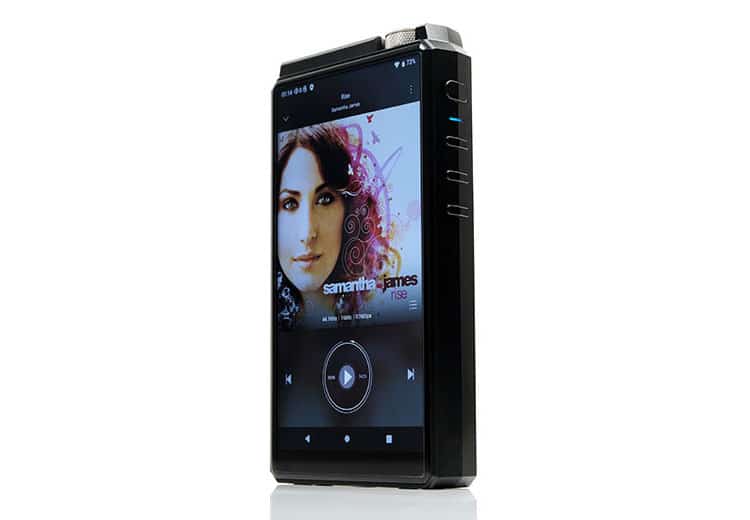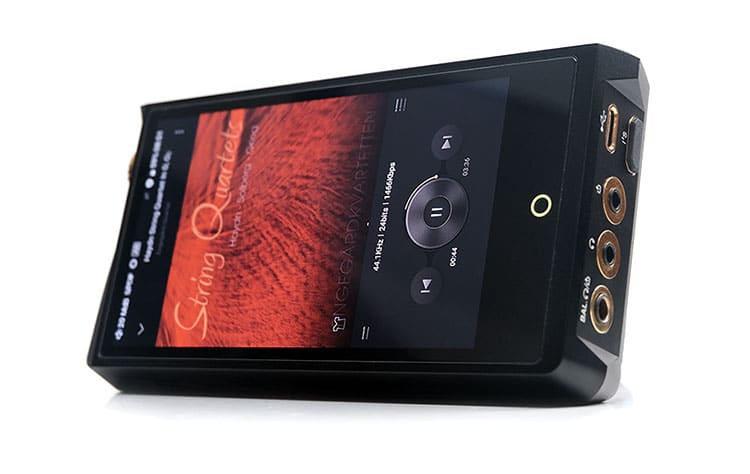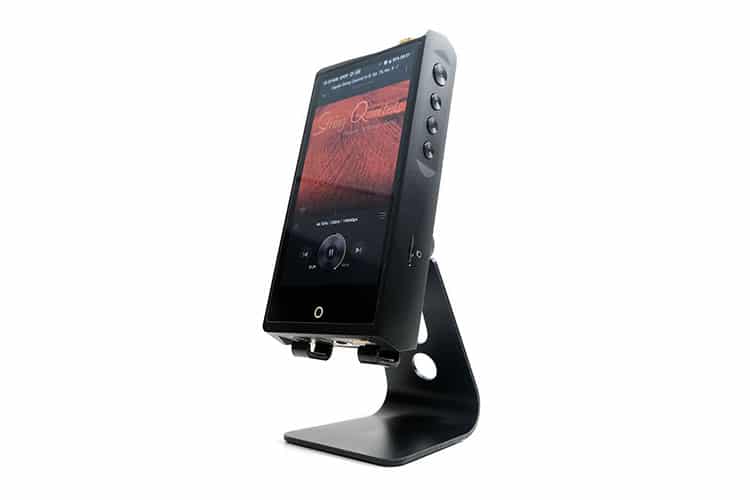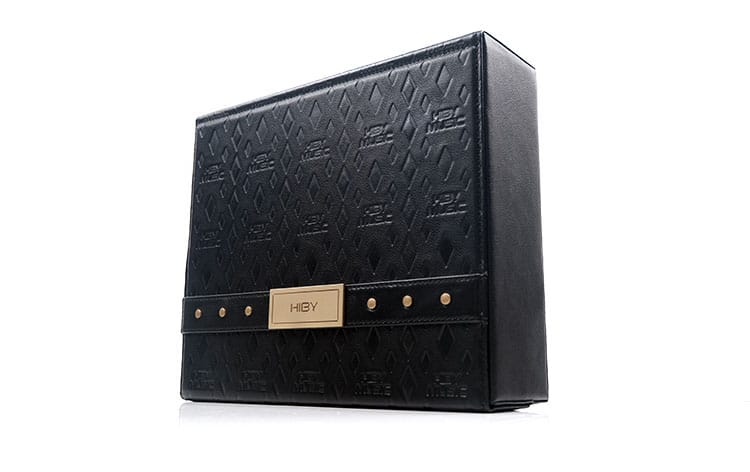Select Comparisons
Comparisons were completed using both the SE and balanced PO outputs of the RS8 paired with the Noble Audio Viking Ragnar and the Empire Ears Odin.
HiBy R8
$1899
The R8 was the predecessor to the RS8 and was well-received by us back in late 2020 including winning our Top Gear Award for 2020. You can read the full R8 review here.
Technical
The most striking change is the digital signal management and subsequent analog conversion with the R8 using an older dual delta sigma AK4497 implementation and the RS8 using the more holistic Darwin Architecture II which includes 92 resisters per channel of R-2R conversion.
In a way, the RS8 is a technological juxtaposition given that R-2R is an older ‘audio technology’ but the Darwin Architecture is something entirely new. The R8’s implementation is bread and butter for DAPs up until maybe the last year or so when, for me, DAP building started to diverge and in a way mature beyond off-the-shelf chipsets.
It is not just the DAC but also the CPU with the R8 using the older Snapdragon 660 and the RS8 using the newer 665 as well as Android 12 over Android 9 and double the RAM going from 4 to 8GB.
I suspect those upgrades are almost born out of necessity to handle the demands of Darwin as our AnTuTu scores for both DAPs were almost the same.
Decoding wide, however, the RS8 is a big jump in headroom with hitherto unheard-of DSD1024 and 32BIT/PCM1536 decoding limits, a count usually reserved for desktop R-2R DACs rather than DAPs.
The R8’s DSD512 and 32bit/768kHz PCM is still ultra-competitive even in today’s market and it can match the RS8’s MQA 16X rate but that 4-digit DSD decoding futureproofing is beyond its abilities.
The one area that the R8 seems to fare well on is the amping output at 1044mW into a 32Ω balanced compared to 780mW on the RS8 for the same output and load. Numbers can be deceiving though, as in our tests I felt the noise floor on the RS8 for sensitive IEMs going balanced was much improved from the noisier R8 equivalent.
Design
The form factor is almost the same save for the RS8 being slightly taller. However, the quality of the materials and subsequent weight are quite different with the RS8 weighing over 150g more than the original and using a much more expensive titanium material compared to aluminum.
You feel that difference right away with the RS8 feeling so much more solid and denser. Neither is very pocketable but the RS8 is more transportable than portable for me, similar to the M17 and the N8ii.
There are some nuanced changes also in the RS8 design. The potentiometer is a little tighter and stiffer giving it a bit more of a premium feel to the looser R8 version. Its etching on the sides for grip is more elaborate also.
The bevel on the glass also has gentler curving instead of the R8 angular finishing giving it a more refined presentation.
The back plate is probably the standout design change with its beautiful monogram patterned finish right on the metal and held in place by 4 exposed screws. It feels a lot more robust than the glass panel of the R8 and quite possibly easier to detach for battery replacement.
Performance
Both are more on the smooth and slightly euphonic side but the key difference here is the improved level of note definition, the textural detail symbolic of a good R-2R performance, and the general realism versus the delta-sigma polished alternative.
The R8 also has some of the key AK4497EQ traits that I found in a lot of devices that use it. That means a slight bias to the lows but with a pillowy full-sounding warm tone then it progressively tails off through the mids and highs thinning it out slightly the higher up you go.
The RS8 has none of that. It sounds denser and meatier right throughout with more snap in the low-end and better layering and note definition. It sounds more planted and visceral and provides much better support for lower-mid notes and vocal performances.
Mids sound further forward and fuller with our IEM pairings whereas the R8 is euphonic, perhaps sweeter but also a shade thinner on the same notes and more relaxed in its imaging.
I was also particularly impressed with the higher pitching percussion timbre on the RS8 compared to the R8. On the R8 it’s a tinnier sounding with more contrast, slightly digital sounding you could say. Whereas the RS8 performance was much richer sounding, more dramatic in its impact yet smoother on the edges at the same time.
The RS8 also did a much better job of filling in the soundstage with wide stereo field monitors such as the Viking Ragnar. For the Odin, it dug a lot deeper also in a more focused and powerful manner. The R8 felt just a little more 2D dimensional with mids and treble fading in dynamics for me in comparison and lacked the same snap on the lows for the Odin.
Luxury & Precision P6 Pro
$3899
The Luxury & Precision P6 Pro is the company’s flagship R2R DAP and was reviewed by us back in the middle of last year. You can read our review of this excellent DAP here.
Technical
Like the RS8, the P6 Pro uses an R-2R digital-to-analog conversion topology. The implementation is 96 tightly matched resistors assembled by hand at 48 per channel whereas HiBy has upped the performance to 92 resistors per channel and with a larger number of high-speed switches.
There isn’t a direct comparison of the resistors used which can be critical in R-2R rail assemblies other than a claimed 0.005% precision resistance from HiBy and 1/10,000 resistors parameters for the P6 Pro.
Because of the more complex R-2R rail design, and I dare say their own digital bridge algorithm for the USB stage, the RS8 decoding capability is a lot more accomplished at DSD1024 and PCM 1536 as well as including BT capability up to UAT and LDAC 24BIT/96kHz and MQA unfolding to 16X.
The P6 Pro limits are lower at 32BIT/384kHz and DSD256 with BT aptX and no MQA unfolding capability. As such, it’s more of a classic pure local storage player with a light dab of lossy streaming capability.
It is ironic then that as a local storage-focused player the P6 Pro only has 64GB of onboard storage with a single MicroSD slot compared to the massive 256GB, OTG flash card expansion, and a MicroSD slot on the RS8.
Amping-wise, they are quite close though the P6 only has a Class A amp whereas the RS8 allows you to choose between Class A and Class AB. The P6 Pro can output up to 700mW from a balanced 32Ω load and 180mW SE whereas the RS8 offers balanced at 780mW on the same load and higher for SE at 280mW for both amplifier classes.
Just watch the SNR though which is substantially better on the P6 Pro at 125dB maximum compared to the top-level 115dB rating on the RS8.
Design
For me the design and form factor of these two talks to very different audiences. The P6 Pro is far smaller and lighter and of the flagship DAPs out there, this is one of the genuinely pocketable ones.
The RS8’s weight and size are less portable-friendly though the huge 12000mAh battery will actually give you a few hours more battery life than the P6 Pro under certain conditions. Yes, the P6 Pro is rated at a healthy 14-15 hours per cycle but in my time using it I find you will be lucky to hit 10 hours using hi-res tracks and going balanced.
Beyond that, it is really about the screen interaction, the level of connectivity, and the OS that makes the difference between these two. The P6 Pro’s small screen with a proprietary touch OS is very basic with album artwork on the playback screen the only nod to a proper GUI.
You do get plenty of tweaks and options such as NOS, DSD, and PCM filters as well as USB-DAC, line out, and SPDIF capability so it can integrate well within a system but with only BT receiving capability and no Wi-Fi this is not going to appeal to a modern connected audiophile.
The RS8’s Android 12, endless tweakability via Darwin, as well as full app access via Wi-Fi, gives it a much more expansive profile. BT is higher at LDAC with lossless streaming via Wi-Fi including streaming via external sources. It’s a much deeper and more modern digital player experience.
Performance
For a long time now, I have considered the P6 Pro to be the best DAP in the market purely on sound quality. The RS8 more or less meets that lofty benchmark though for different tuning reasons.
They both have that smooth analog-like natural R-2R coloration and textural quality but the tuning bias of both my tested monitors shifted a little when paired with each. So, which one you choose might be more down to a preference factor than outright superiority of one over the other.
For example, the RS8 teases out a much more holographic soundstage with more headroom and a stronger treble presence compared to the P6 Pro. That gels well with the Viking Ragnar’s massive staging quality filling out the stereo field a lot more giving a more complete picture of the track being played.
The P6 Pro has more of a bias to the lows and mids, especially vocals with a smoother treble, perhaps more attenuation there also. It’s stronger for bass density and has a thicker vocal texture with a slightly more rounded quality and reduced treble overtone.
That signature paired really well with the Empire Ears Odin which has a stronger bass bias and sub-bass rumble compared to the Viking Ragnar. It’s ‘studied’ upper mids do not like to be overexcited with treble overtones and the P6 Pro manages that very well.
Now some will prefer the RS8’s more neutral midrange with the Odin and indeed it does seem to deliver a slightly more distant imaging experience compared to the P6 Pro. It is not as intimate, which leads me back to the impression of an expansive staging quality with the RS8 versus the robust but more intimate delivery of the P6 Pro.
Cayin N8ii
$3499
We reviewed the Cayin N8ii a few weeks ago so it is still quite fresh in our memories. You can read up about their flagship tube-based DAP in more detail here.
Technical
Both of Cayin’s legacy devices, the N8, and the R8, used delta-sigma AK4497EQ implanted DACs, and both successors, the RS8 and the N8ii diverged from digital norms with more unique offerings.
In the case of the N8ii, the choice was still delta-sigma but an entirely new dual ROHM BD34301EKV chipset offering up to DSD512 natively and a maximum of PCM 32BIT/768kHz when using it as a USB-DAC or in I²S mode. You also get a very competitive MQA unfolding rate of 16x, (up to 768kHz) which is the same as the RS8.
The RS8’s 92 per channel resistor R-2R implementation has gone one step further with DSD0124 and PCM32BIT/1536 capability and the same MQA up to 16X. Both offer BT with LDAC up to 24BIT/96kHz and both include HiBy’s proprietary UAT technology for even higher BT transmission rates.
Both DAPs have a similar visioning being able to choose between a Class A or a Class AB operational mode for amplification but here, the N8ii diverges considerably by packing in a tube amplifier alongside solid-state allowing you two further timbre choices, tube or solid-state.
You can choose either timbre and Class in whatever combination for a total of 4 types of flavors as opposed to 2 on the RS8. Cayin also has its own version of the RS8’s Turbo mode called P+ which does offer a qualitative improvement in dynamic range on higher loads.
Both of these DAPs have very similar output ratings at 750mW into 32Ω balanced and 240mW SE for the N8ii compared to 780mW and 280mW under the same conditions for the RS8. Again, like the P6 Pro comparison, the SNR seems better on the N8ii on paper at 125dB maximum for its solid-state operational mode compared to 115dB for the RS8.
Design
The form factor of the N8ii is bigger compared to the RS8, however, the RS8 is the heavier of the two at 584g compared to 442g. You will feel that difference quite readily though neither of them is as portable as the P6 Pro.
Much of the weight difference can be explained by the use of titanium for the RS8 housing compared to the N8ii’s lighter aluminum shell. The additional height of the N8ii allows both of the Korg NuTubes to fit in a vertical position on the left side of the PCB.
The finishing, including the use of titanium and the monogram patterning, favors the RS8. Visually some will prefer the black and gold accents on the N8ii but the glass back panel might be a bit more fragile on it. The ability to see the N8ii tubes at work with their green glow on the recessed left panel is a highlight visually.
I give credit for Cayin including a mini I²S socket which expands connectivity and allows a degree of modular compatibility with a wide range of DACs. Otherwise, both offer similar LO and PO options with USB-C wired connectivity.
For UI, the N8ii is a step behind the RS8 with a smaller 5″ 780p sized IPS panel combined with a thicker bezel and the somewhat awkward glow ring and gesture navigation system. Android 9 is also dated and less customizable compared to the RS8’s Android 12.
The N8ii also uses a lower Snapdragon 660 compared to the RS8’s 665 and with 6GB of RAM compared to 8GB. Despite that, the N8ii is competitive in our benchmark testing with the RS8 actually scoring 1-2k less. I suspect the demands of Darwin are a factor in the RS8 performance though both are very responsive.
Class AB Performance
The pure AB transistor side of the N8ii is probably the weaker of the choices here when lined up against the RS8. Using the Odin, you do get a nice sub-bass presence and decent punch but it sounds ‘smaller’, not as full-blooded, and with less warmth and textural detail compared to the RS8.
There is also something about timing in the RS8 performance which felt somewhat more enjoyable, perhaps due to a stronger sub-bass presence giving it a more rhythmic tone with the excellent dynamic drivers in the Odin.
I didn’t get the same joy with the solid-state AB delivery in the N8ii which came off a bit cooler, with more treble dissonance also in the mids timbre and a slightly digital overtone on the highs. It also sounded a bit more compressed and not as open or as expansive as the RS8.
Class AB/Tube Performance
The Class AB/Tube timbre of the N8ii is a much better contender against the RS8 with a more liquid analog coloration that I tend to prefer and a richer bass punch to go along with it.
In comparison, the Class AB of the RS8 seems a little calmer or more linear-sounding with the neutral imaging of the Viking Ragnar midrange.
The N8ii vocal imaging is more upfront for me with the same pairing and with a bit more treble forwardness though this time the timbre is a bit smoother and denser sounding.
The RS8 seems to have the edge in pure extension but with a slightly more delicate upper treble portrayal. Still very pure sounding for me but not quite as ‘tube rich’ in texture.
Class A Performance
One key issue with the N8ii Class A performance with any timbre selected is the inability to turn on the P+ mode which is equivalent to the RS8’s Turbo mode. With the RS8 you can have Turbo mode on for Class A.
Turning Turbo mode off and going like for like the Class A implementation of the N8ii is slightly smoother and more full-bodied in its delivery when paired with the Viking Ragnar.
Just a slight vocal emphasis here stretches the N8ii stage a bit more for me whereas the RS8 stays more linear and neutral and dropping the vocal back and pushing the treble just a tiny bit further forward. The overall effect is a marginally cleaner more neutral tone and level of note body in the upper mids and treble from the RS8 Class A.
The RS8 Class A with Turbo Mode on is much more dynamic in its delivery sounding bolder and more impactful than the smoother evenly weighted Class A of the N8ii using the Ragnar. You get more depth and power but you also get a bit more contrast from the treble so essentially it is more vivid and exciting sounding.
Class A Tube Performance
Without RS8 Turbo mode on, the N8ii Class A tube performance has a bit more oomph and richness in its performance, especially in the mid-bass punch and vocal texture. There is also a bit of euphonic sweetness in its delivery that takes the edge off some great treble extension ensuring it lacks any harshness with both the Odin and the Viking Ragnar.
With the RS8, both IEM pairings sound more to the solid-state side with a little bit more leanness in the upper mids and treble and just a tiny bit more harmonic dissonance over the higher-pitching instrumental coloration.
The imaging and staging quality is much the same from both in terms of the RS8 being the more expansive of the two but more linear through the mids and not quite as upfront as the N8ii for vocal performance.
Turbo mode on the RS8 offers a lot more “drive” than the Class A Tube performance from the N8ii, particularly on the lows that are a lot more vivid in their delivery on the Odin.
It is still more of a solid-state sound and a little more precise and less liquid but the R-2R DAC does an excellent job disguising that for me so it is more of a halfway house with more energy but still smooth sounding.
Our Verdict
The HiBy RS8 is one of the most complete DAPs launched to date. It has the most advanced operating system, a unique architecture evolved from the RS6, and quite obviously packs in my DAC of choice, R-2R.
Not just R-2R for the sake of it but desktop decoding levels of R-2R and a level of audible quality that competes with the gold standard, the P6 Pro from Luxury and Precision.
I have been waiting for an Android R-2R DAP that really delivers and the RS8 does that and then some. That natural and coherent sound is beguiling to listen to for hours and hours.
What needs to be improved sounds churlish but we would be remiss without the cons as well as the pros. It is big and heavy for one thing and personally, Class A and Class AB are not distinct enough leading me to just keep it in Class A out of pure audiophile snobbery. More daring Darwin presets from the manufacturers would not go amiss either.
Otherwise, the RS8 may well have set the standard for what is possible with this ‘new old’ technology.
HiBy RS8 Technical Specifications
- R2R Based Advanced Darwin Architecture.
- Class A Amplification.
- Pure Titanium Chassis.
- Turbo Power Mode.
- NOS/OS Modes.
- High-End Components on the audio circuitry.
- Supports DSD512 and PCM32-Bit/768kHz audio signals.
- Femtosecond precision crystal oscillators.
- 12000mAh large battery.
- Specially designed Pure Copper Battery case for heat dissipation.
- Qualcomm’s advanced Snapdragon 665 Processor.
- 8GB RAM, 256GB ROM.
- Open Android 12 OS.
- 5’ 1080P Display.
- DTA Systemwide Android Sample Rate Bypass.
- 16x MQA Unfolding.
- 3.5mm+4.4mm Headphone+Line Outputs.
- Dual-Band Wi-Fi.
- Bluetooth V5.0 Wireless connectivity.
- PD2.0 Fast Charging.










